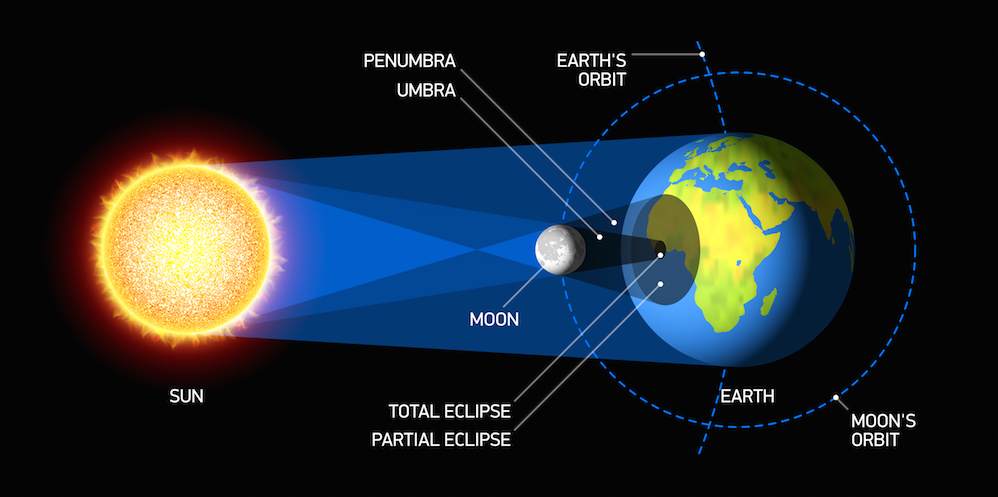Every year we usually read something about Solar Eclipse and Lunar Eclipse. Recently there was a News regarding Solar Eclipse. What exactly these two are? What is the difference between them? How is it occurring? This Post will deal with these questions in detail.
This Topic is also very important in Exam Point of View. So understand the concepts clearly. It is very simple.
Solar Eclipse and Lunar Eclipse
What is Eclipse?
An eclipse takes place when one heavenly body such as a moon or planet moves into the shadow of another heavenly body. In simple words, sometimes during their orbits, the moon and the Earth form a line with the Sun. When this happens, an eclipse occurs.
What is Solar Eclipse?
Earth orbits Sun. Moon orbits Earth. I hope everyone knows this concept.
Sometimes when the moon orbits Earth, it moves between the sun and Earth. When this happens, the moon blocks the light of the sun from reaching Earth. This causes an eclipse of the sun, or solar eclipse. During a solar eclipse, the moon casts a shadow onto Earth.
What are the Types of Solar Eclipse?
Total Solar Eclipse
A total solar eclipse is only visible from a small area on Earth. The people who see the total eclipse are in the center of the moon’s shadow when it hits Earth. The sky becomes very dark, as if it were night. For a total eclipse to take place, the sun, moon and Earth must be in a direct line.
Partial Solar Eclipse
This happens when the sun, moon and Earth are not exactly lined up. The sun appears to have a dark shadow on only a small part of its surface.
Annular Solar Eclipse.
An annular eclipse happens when the moon is farthest from Earth. Because the moon is farther away from Earth, it seems smaller. It does not block the entire view of the sun. The moon in front of the sun looks like a dark disk on top of a larger sun-colored disk. This creates what looks like a ring around the moon.
More about Solar Eclipse
During a solar eclipse, the moon casts two shadows on Earth. The first shadow is called the umbra (UM bruh). This shadow gets smaller as it reaches Earth. It is the dark center of the moon’s shadow.
The second shadow is called the penumbra (pe NUM bruh). The penumbra gets larger as it reaches Earth. People standing in the penumbra will see a partial eclipse. People standing in the umbra will see a total eclipse.
Solar eclipses happen once every 18 months.
NEVER look directly at the sun: It can permanently damage your eyes! You must use proper safety equipment to look at any type of solar eclipse.
What is Lunar Eclipse?
The moon moves in an orbit around Earth, and at the same time, Earth orbits the sun. Sometimes Earth moves between the sun and the moon. When this happens, Earth blocks the sunlight that normally is reflected by the moon. (This sunlight is what causes the moon to shine.) Instead of light hitting the moon’s surface, Earth’s shadow falls on it. This is an eclipse of the moon — a lunar eclipse. A lunar eclipse can occur only when the moon is full.
What are the Types of Lunar Eclipse?
Total Lunar Eclipse
A total lunar eclipse occurs when the moon and the sun are on exact opposite sides of Earth. Although the moon is in Earth’s shadow, some sunlight reaches the moon. The sunlight passes through Earth’s atmosphere, which causes Earth’s atmosphere to filter out most of the blue light. This makes the moon appear red to people on Earth.
Partial Lunar Eclipse
A partial lunar eclipse happens when only a part of the moon enters Earth’s shadow. In a partial eclipse, Earth’s shadow appears very dark on the side of the moon facing Earth. What people see from Earth during a partial lunar eclipse depends on how the sun, Earth and moon are lined up.
A lunar eclipse usually lasts for a few hours. At least two partial lunar eclipses happen every year, but total lunar eclipses are rare. It is safe to look at a lunar eclipse.
Watch this wonderful video to understand Solar Eclipse and Lunar Eclipse in a better way!!!
What is the Difference between Solar Eclipse and Lunar Eclipse?
|
Parameters |
Lunar Eclipse |
Solar Eclipse |
| Health risk
|
Safe to look at moon during eclipse | Retina gets damaged if Sun seen directly with a naked eye |
| Position of Earth and Moon | Earth lies between the Sun and Moon | Moon lies between Sun and Earth |
| Occurrence | At Night | During Day Time |
| Frequency of occurrence | Twice a year or more | A few every year, total being less frequent |
| Visibility | Moon completely obscured, visible partially or in an orangish hue –visible from all night time places | Sun gets blocked by moon – eclipse visible only in some areas |
| Duration | A few hours | Usually a few minutes |
| Types | Penumbral, partial, total or horizontal | Total, annular, hybrid, partial |
Here comes the Question for those who read this Article. If possible try to answer the question in comment section.
Why isn’t there an eclipse at every NEW moon and at every FULL moon?
Want to read more Articles?
Then Explore DayTodayGK’s ARTICLE SECTION


















